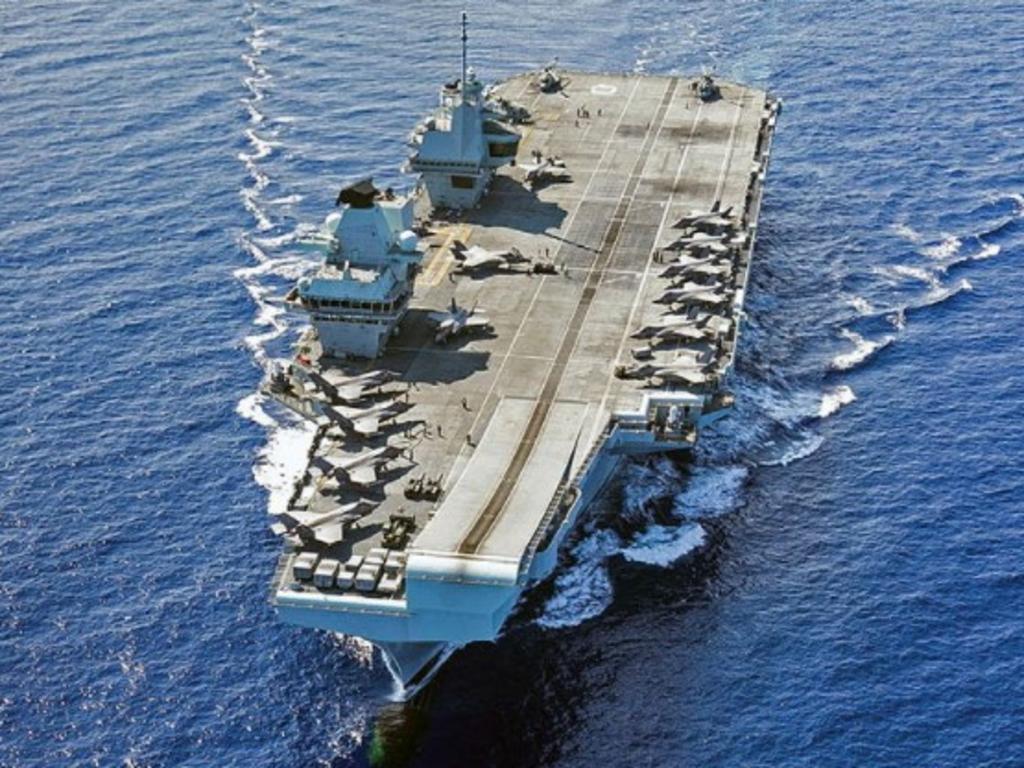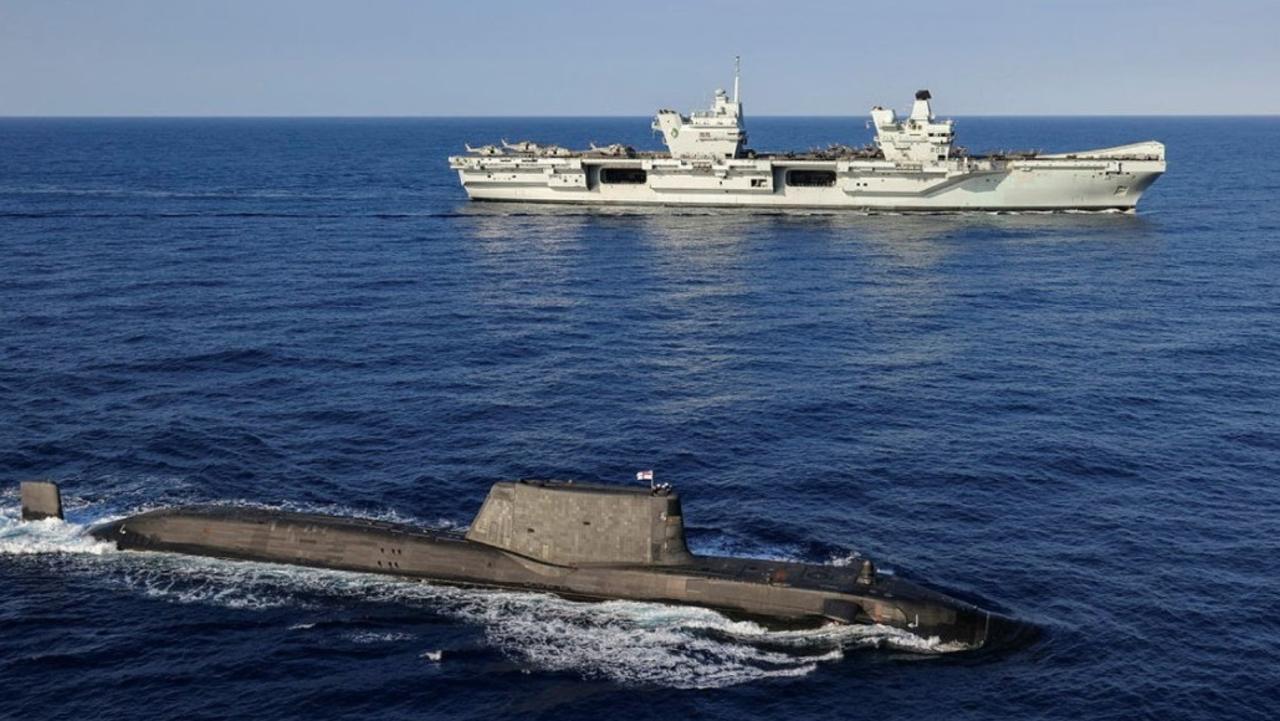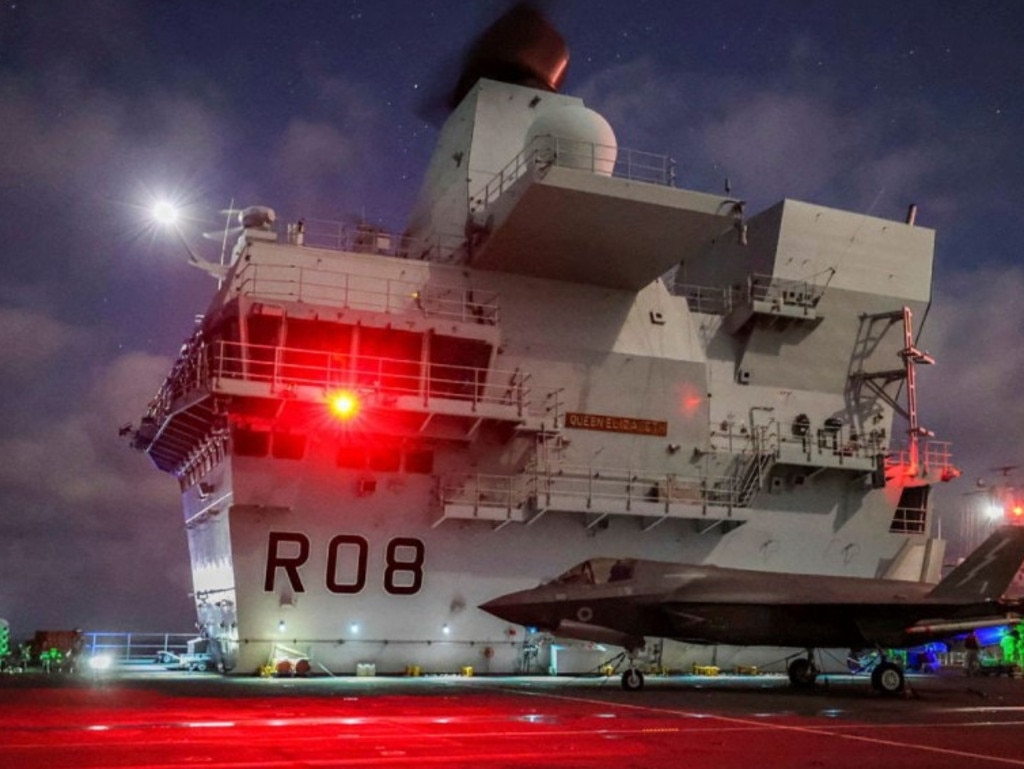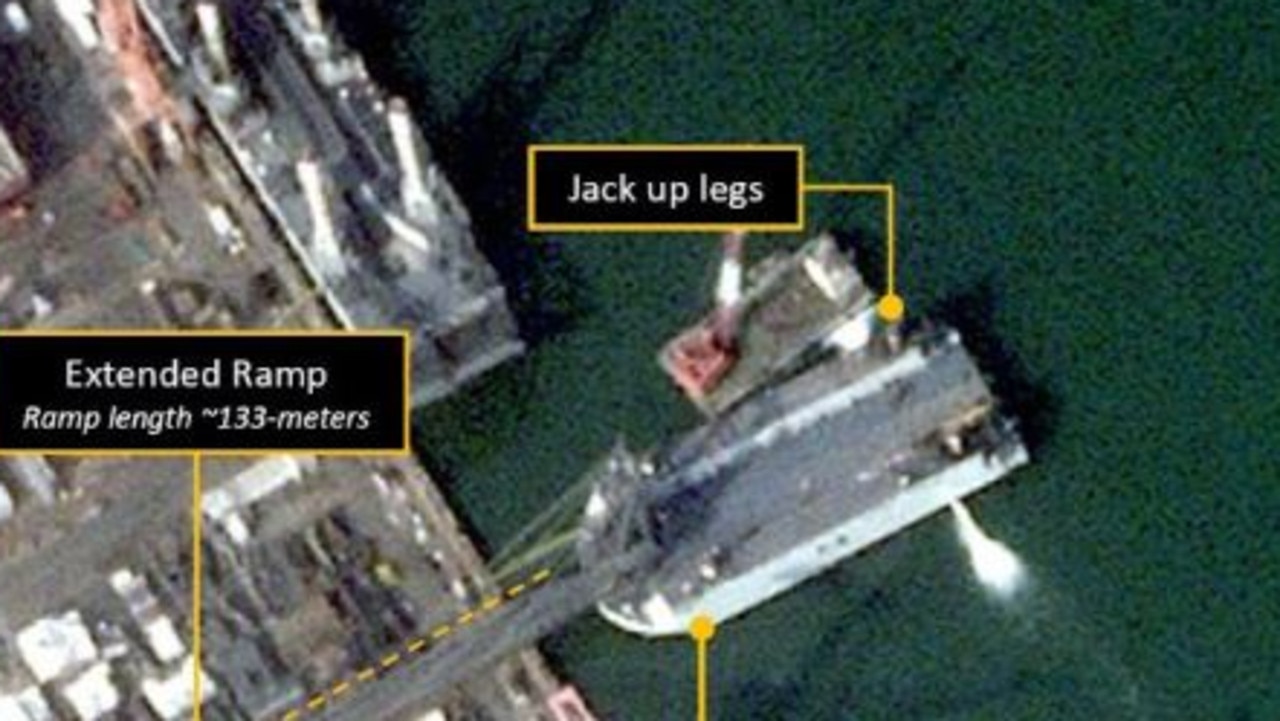Beijing’s threatens UK after HMS Queen Elizabeth enters South China Sea
A power struggle has erupted after an aircraft carrier challenged China’s South China Sea rule. Beijing says there will be consequences.

China says it has launched multiple military drills as the United Kingdom’s aircraft carrier HMS Queen Elizabeth enters the South China Sea. It calls the ship’s visit “colonial”. It warns that if it “intrudes” on Chinese-claimed islands and reefs, it will be “expelled”.
“China will end the struggle between hegemony and anti-hegemony forces with the US. All other countries outside the region are advised to stay away from this confrontation to avoid ‘accidental injury’,” a hostile state-controlled media editorial warns.
RELATED: Pushback after China’s ‘aggressive’ move

Is Beijing worried?
Until now, the only nation to directly challenge Beijing’s rejected 12 nautical mile (22km) sovereignty claims has been the United States. It did so again Thursday, with the destroyer USS Benfold passing through the troubled Taiwan Strait.
But the world is watching to see if London will join the US in crossing such “red lines”.
#环çƒæ—¶æŠ¥Editorial: The Queen Elizabeth carrier strike group’s navigation to the South China Sea was the UK’s effort to show its presence in the region. We seriously warn this group: They are obliged to remain restrained and obey the rules. https://t.co/xVKTTd28zEpic.twitter.com/MR1GhkV4Bg
— Global Times (@globaltimesnews) July 29, 2021
“Sending a warship within 12 miles of Chinese territory is a direct challenge to China’s core interests, which might result in misjudgment,” the Chinese Communist Party-controlled Global Times warns.
Other nations, including Australia, have limited themselves to operating warships in nearby international waters and shipping lanes.
Beijing’s uptight enough over the idea to talk even tougher than usual.
“An old saying in China goes that if you want to punish someone, you need to consider saving face for his big brother,” Chinese military analyst Song Zhongping is quoted as saying. “However, what China will do is just the opposite: China will make it clear to the US that London will be punished by acting like Washington’s running dog in provoking Beijing.”
Innocent Passage?
Beijing warns: “We advise US allies to be particularly cautious, keep a significant distance from China’s red lines and refrain from pushing ahead. If their warships rampantly behave as the US military does in the South China Sea, they will more likely become an example of China defending its sovereignty and territorial integrity”.
HMS Queen Elizabeth spotted about 53.9 NM east-southeast of Vanguard Bank, #SouthChinaSea, Jul 28.
— SCS Probing Initiative (@SCS_PI) July 28, 2021
Image credit to @lobsterlarryliu via @planet. pic.twitter.com/LK3TYJaWri
Beijing-based university think-tank South China Sea Probing Initiative located HMS Queen Elizabeth and consorts crossing China’s arbitrary “nine-dash line” on Wednesday.
“China is holding multiple military exercises in sea areas including the Bohai Strait, the Yellow Sea and the South China Sea,” Beijing stated in response to the news.
Open-source intelligence enthusiasts soon also spotted the Chinese aircraft carrier PLAN Shandong operating in the Northern South China Sea.
Closer together. pic.twitter.com/ebD119lyX4
— Duan Dang (@duandang) July 29, 2021
Beijing accuses London of grandstanding. So, it’s returning the favour.
“The Chinese People’s Liberation Army (PLA) will stand ready to deal with any improper acts by the UK warships and see their South China Sea tour as a chance for practice,” the Communist Party-controlled Global Times warned.
RELATED: China’s fear behind spy ship move

Two of the military exercises are in the South China Sea. Both are off Hainan Island and the mainland’s Guangdong Province, where the PLAN Shandong was spotted.
“Just like US warships that intruded Chinese islands and reefs in the region, if UK vessels do the same, they will also be expelled by the PLA”.
‘A chance for practice’
China claims almost all the South China Sea, even though it is bordered by Vietnam, the Philippines, Malaysia and Indonesia. An international court of arbitration in 2016 judged this “nine-dash line” territorial assertion to be without merit.
Beijing rejected the verdict.
It has since continued to escalate assertive acts by its navy, coast guard and fishing militia in the region. Its controversial artificial island fortresses have been armed.
But it insists Western nations are the main threat to peace in the region.
#环çƒæ—¶æŠ¥Editorial: China will end the struggle between hegemony and anti-hegemony forces with the US. All other countries outside the region are advised to stay away from this confrontation to avoid “accidental injury.†https://t.co/uOIWj1rI4Ipic.twitter.com/ZokF1iKQkB
— Global Times (@globaltimesnews) July 29, 2021
The multinational task force, led by the new aircraft carrier HMS Queen Elizabeth, comprises several Royal Navy escort and support vessels along with the American USS The Sullivans guided-missile destroyer and Royal Netherlands Navy HNLMS Evertsen frigate. Other nations are dipping in and out of the formation as it makes its way through Southeast Asia.
“The carrier and its escort ships will likely hold exercises in the South China Sea or conduct so-called freedom of navigation operations on Chinese islands and reefs, potentially similar to the HMS Defender destroyer’s doing in the Black Sea last month,” reports Chinese media.
The UK’s ministry of defence has said as much. But Beijing won’t let the carrier’s presence go unopposed: “The PLA will closely monitor the UK warships’ activities, stand ready to deal with any improper acts, and also see this as a chance for practice and for studying the UK’s latest warships up close.”
Friends in need
“The Chinese side believes that the South China Sea should not become a sea of great power rivalry dominated by weapons and warships,” Beijing defence department spokesman Tan Kefei told the Hong Kong-based South China Morning Post, without reference to its heavily armed island fortresses or naval intimidation of Vietnamese, Philippine and Malaysian fishing and resource exploration operations.
“The real source of militarisation in the South China Sea comes from countries outside this region sending their warships thousands of kilometres from home to flex muscles.”
But the UK, US and Netherlands say the aircraft carrier task force is exercising its rights under the International Convention on the Law of the Sea.
Beijing says London “is still living in its colonial days”.
“The UK intends to use its navy to revive its old dream of an empire, but its overall strength cannot support such global ambitions,” a Global Times opinion piece accuses.

But it’s not an argument that withstands the test of time, says Council on Geostrategy contributor Dr Bill Hayton.
“It is both lazy and inaccurate,” he writes.
The former colonies of Malaysia and Singapore became independent sixty years ago, he says. Brunei in 1984. “Moreover, all those countries – and many others besides – have invited the UK to make port visits … and take part in combined exercises because of their own concerns about security in the region.
“In an uncertain environment, these countries are reaching out to countries that share the same concerns, such as the UK, for mutual support.”
When push comes to shove
Analysts believe the chances of a showdown between the likes of PLAN Shandong and HMS Queen Elizabeth are slim.
The only direct confrontation between a Chinese and foreign warship in recent times happened in 2018. Then, the destroyer PLAN Luyang forced the destroyer USS Decatur to change course to avoid a collision.
US Secretary of Defense Lloyd Austin was visiting Singapore as the HMS Queen Elizabeth passed by. He joined the UK’s ambassador in rejecting China’s aggressive assertions.
A brilliant and busy time, we have now passed through the Strait of Malacca.
— HMS Queen Elizabeth🇬🇧 (@HMSQNLZ) July 27, 2021
We sailed with ships of the Royal Malaysian Navy 🇲🇾 @tldm_rasmi and with the Republic of Singapore Navy 🇸🇬 @mindefsg and got some great team photos! 📷 ⚓@UKinMalaysia@UKinSingapore#CSG21pic.twitter.com/19D2TTMysb
“Beijing’s claim to the vast majority of the South China Sea has no basis in international law,” he said Tuesday. “That assertion treads on the sovereignty of states in the region. We continue to support the region’s coastal states in upholding their rights under international law.”
For its part, Beijing has no formal alliances.
This is why the idea of India, Japan, Australia, and the United States turning the Quadrilateral Agreement into a defensive pact has it unsettled. And the presence of the UK-led task force reviving old Cold War friendships represents a further hardening of regional resolve.
Somewhere at sea.
— HMS Queen Elizabeth🇬🇧 (@HMSQNLZ) July 13, 2021
Carrier Strike, Amphibious Assault, Destroyers and Frigates. A range of ships, a wealth of capability!💪ðŸŒðŸ‡¬ðŸ‡§ðŸ‡ºðŸ‡¸ðŸ‡³ðŸ‡±ðŸŒ@RoyalNavy@UKdefUS@USNavy@USMC@US5thFleet@HNLMS_Evertsen@HMS_Richmond#USSRONALDREAGAN#USSIWOJIMA#USSTHESULLIVANS#USSHALSEY#USSSHILOHpic.twitter.com/uz47GWCrd6
“While the warships in themselves pose some threat to China, the tour’s political influence is a bigger threat because other Western countries like Australia and Canada could also follow and form this joint fleet that regularly sails the South China Sea and East China Sea, with the aim of confronting China,” says Song.
The idea of a Western Pacific naval “Standing Force” was floated in June. The proposal is modelled on the Cold War-era force of international warships assembled against the Soviet Union in the North Atlantic
“It remains to be seen if this will happen, but even if it does, China will be able to dissolve the threat,” Song added.
Jamie Seidel is a freelance writer | @JamieSeidel




